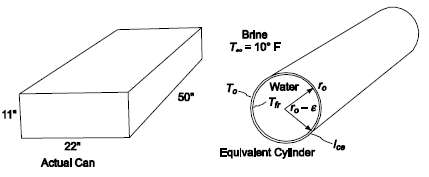In the manufacture of can ice, cans having inside dimensions of 11 by 22 by 50 in.
Question:
In the manufacture of can ice, cans having inside dimensions of 11 by 22 by 50 in. with 1- in. inside taper are filled with water and immersed in brine at a temperature of 10?F.[For details of the process see (81).] For the purpose of a preliminary analysis, the actual ice can be considered as an equivalent cylinder having the same cross-sectional area as the can, and end effects may be neglected. The overall conductance between the brine and the inner surface of the can is 40 Btu/(h ft2 ?F). Determine the time required to freeze the water and compare with the time necessary if the brine circulation rate were increased to reduce the thermal resistance of the surface to one-tenth of the value specified above. The latent heat of fusion of ice is 143.5 Btu/lbm, its density is 57.3 lbm/ft3, and its thermal conductivity is 1.28 Btu/(h ft ?F).GIVENIce formation within a can immersed in a brine solutionCan dimensions: 11 in x 22 in x 50 in (with a 1 in. taper)Brine temperature (T??) = 10?FOverall heat transfer coefficient between the brine and the outer surface of the can (ho) = 40 Btu/ (h ft2 ?F)Ice propertiesLatent heat of fusion (Lf) = 143.5 Btu/lbmDensity (ρ) = 57.3 lbm/ft3Thermal conductivity (k) = 1.28 Btu/(h ft ?F)ASSUMPTIONSSteady stateThe capacitance of the layer can be neglectedThe brine temperature is constant and uniformThe can can be treated as a cylinder having the same cross-sectional areaEnd effects arenegligible

Step by Step Answer:

Principles of heat transfer
ISBN: 978-0495667704
7th Edition
Authors: Frank Kreith, Raj M. Manglik, Mark S. Bohn





